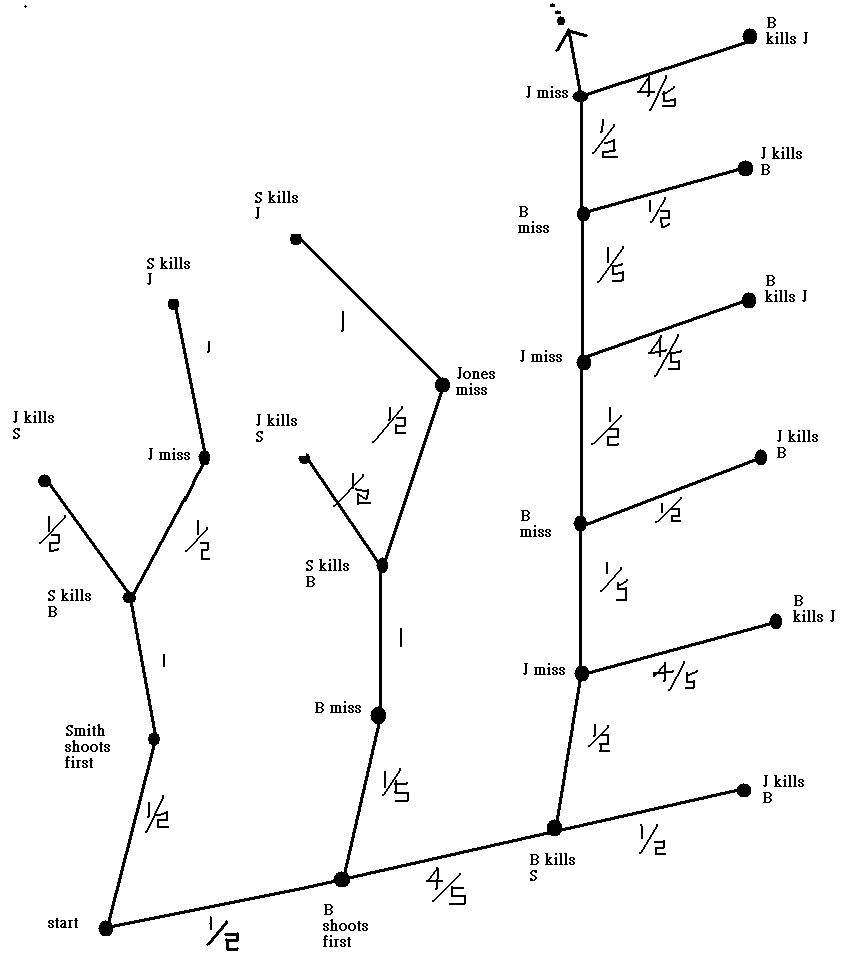
A Hypergame
What is a hypergame? See here.
The following problem can be classified as hypergame.
---------------------------------------------------------------------------------------------------------------------------------------------------------------------------------
Game The Triangular Duel
Smith, Brown and Jones agree to fight a pistol duel under the following unusual conditions. After drawing lots to determine who fires first, second and third, they take their places at the corners of an equilateral triangle. It is agreed that they will fire single shots in turn and continue in the same cyclic order until two of them are dead. At each turn the man who is firing may aim wherever he pleases.
All three duelists know that Smith always hits his target, Brown is 80 per cent accurate and Jones is 50 per cent accurate.
Assuming that all three adopt the best strategy, and that no one is killed by a wild shot not intended for him, who has the best chance to survive?
A more difficult question: What are the exact survival probabilities of the three men?
Answer :
In the triangular pistol duel the poorest shot, Jones, has the best chance to survive. Smith, who never misses, has the second best chance. Because Jone's two opponents will aim at each other when their turns come, Jone's best strategy is to fire into the air until one opponent is dead. He will then get the first shot at the survivor, which gives him a strong advantage.
Smith's survival chances are the easiest to determine:
There is a chance of 1/2 that he will get the first shot in his duel with Brown, in which he kills him. There is a chance of 1/2 that Brown will shoot first, and since Brown is 4/5 accurate, Smith has a 1/5 chance of surviving.
Hence, Smith's chance of surviving Brown is: 1/2 + 1/2 x 1/5 = 3/5.
Jones, who is accurate half the time, now gets a crack at Smith. If he misses, Smith kills him. So Smith has a survival chance of 1/2 against Jones. Smith's overall chance of surviving is therefore: 3/5 x 1/2 = 3/10
Brown's case is complicated because we run into infinite series of possibilities.
His chance of surviving against Smith is 2/5 ( as we saw above that Smith's survival chance against Brown was 3/5 and since one of the two men must survive, we subtract 3/5 from 1 to obtain Brown's chance of surviving against Smith).
Brown now faces fire from Jones. There is a chance of 1/2 that Jones will miss, in which case Brown has a 4/5 chance of killing Jones. Up to this point, then, his chance of killing Jones is 1/2 x 4/5 = 4/10.
But there is a 1/5 chance that Brown may miss, giving Jones another shot. Brown's chance of surviving is 1/2; then he has a chance of 4/5 chance of killing Jones again, so his chance of surviving on the second round is 1/2 x 1/5 x 1/2 x 4/5 = 4/100.
If Brown misses again, his chance of killing Jones on the third round will be, again, 4/1000; if he misses once more, his chance on the fourth round will be 4/10000, and so on.
Brown's total survival chance against Jones is thus the sum of the infinite series:
4/10 + 4/100 + 4/1000+4/10000+......
This can be written as the repeating decimal 0.44444444... , which is the decimal expansion 4/9.
As we saw earlier, Brown had a 2/5 chance of surviving Smith; now, we see that he has a 4/9 chance to survive Jones. His overall survival chance is therefore 2/5 x 4/9 = 8/45.
Jones's survival chance can be determined in similar fashion, but of course we can get it immediately by subtracting Smith's chance, 3/10 and Brown's chance, 8/45, from 1. This gives Jones an overall survival chance of 47/90.
The entire duel can be conveniently graphed by using the tree diagram shown. So it is also a ''game as tree''
It begins with only two branches because Jones passes if he has the first shot, leaving only two equal possibilities: Smith shooting first or Brown shooting first, with intent to kill. One branch of the tree goes on endlessly. The overall survival chance of an individual is computed as follows:

( S kills J=Smith kills Jones J kills S=Jones kills Smith S kills B=Smith kills Brown B kills S=Brown kills Smith
J kills B=Jones kills Brown B kills J=Brown kills Jones J miss=Jones misses B miss=Brown misses )
1. Mark all the ends of branches at which the person is sole survivor.
2. Trace each end back to the base of the tree, multiplying the probabilities of each segment as you go along. The product will be the probability of the event at the end of the branch.
3. Add together the probabilities of all the marked end-point events that the person is the only survivor. The sum will be the overall survival probability for that person.
In computing the survival chances of Brown and Jones, an infinite number of end-points are involved, but it is not difficult to see from the diagram how to formulate the infinite series that is involved in each case. Your exercise is to formulate the infinite series that is involved in each case.
-------------------------------------------------------------------------------------------------------------------------------------------------------------------------------
Exercise: This game can be generalized to a multi-player game. Your exercise is to construct a similar game like this with multiple number of players involved. Then sketch a tree diagram as above. Find the probability that a player is a sole survivor for each person.
-------------------------------------------------------------------------------------------------------------------------------------------------------------------------------